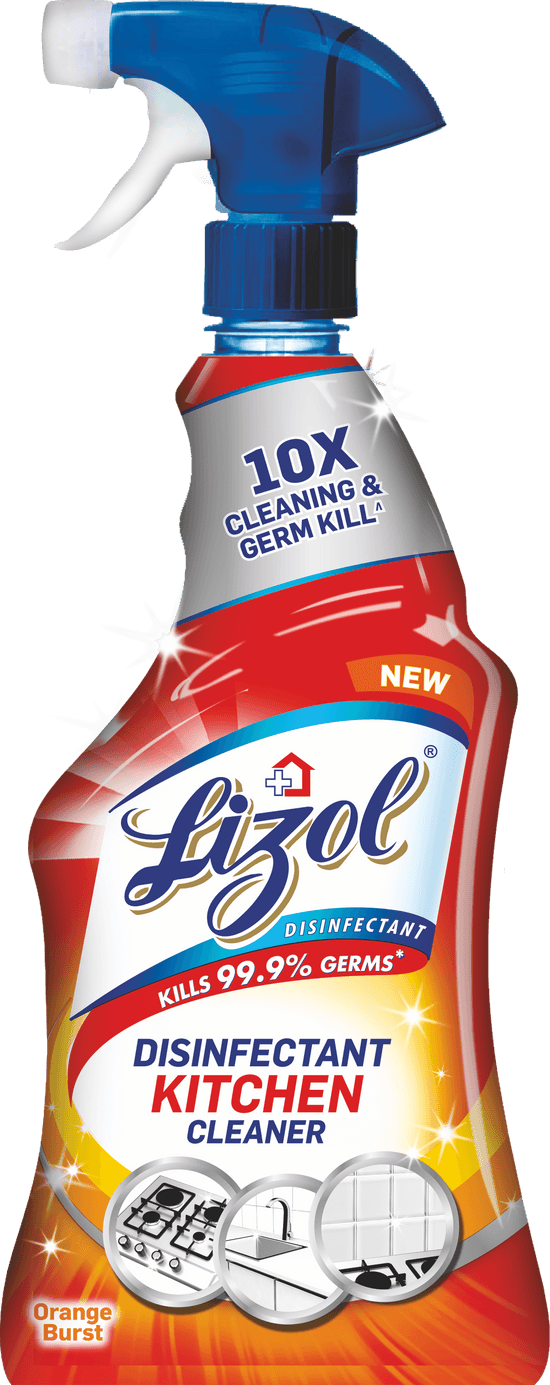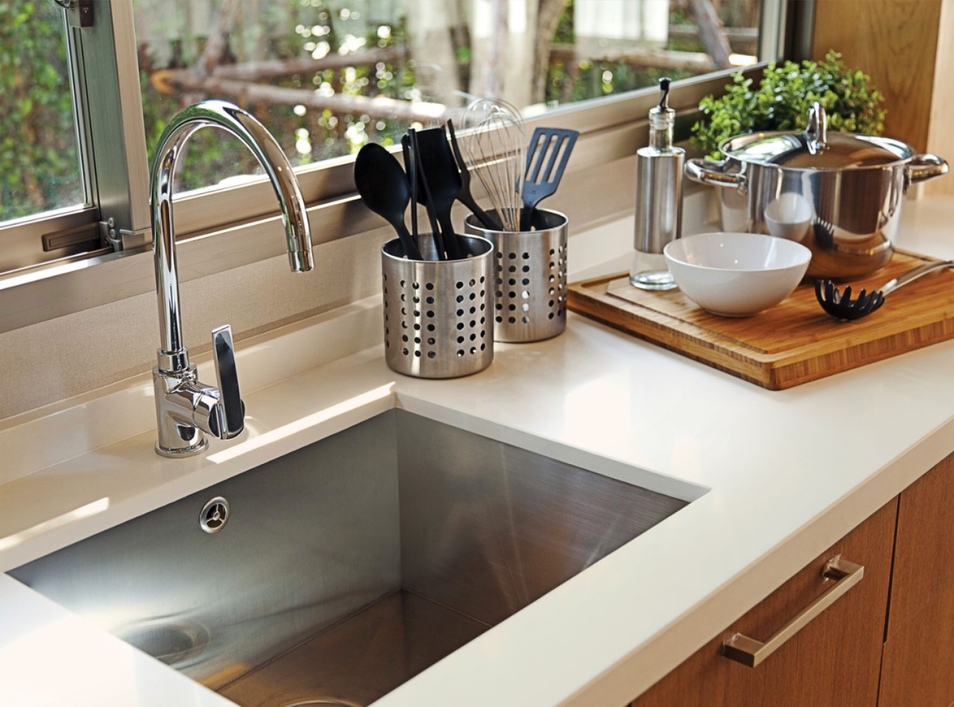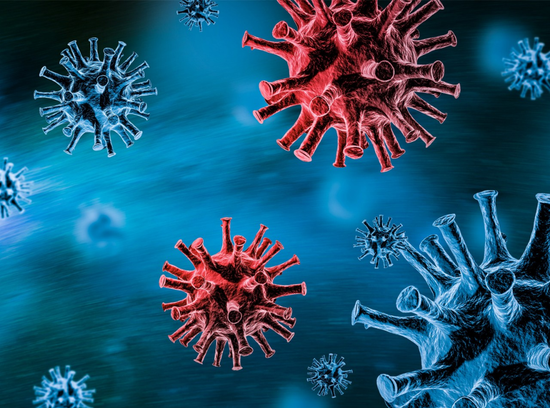
Kitchen Cleaning

The kitchen is the heart of the home. So, to keep it clean and organized becomes the topmost priority of every household. However, unlike other areas of the house, cleaning the kitchen involves a lot more than just activities like vacuuming, sweeping and dusting in order to keep it sparkling clean and safe for your family.
One of the main reasons being that food and cooking materials attract germs. From greasy spills to cross-contaminations and leftovers, the kitchen can harbour more bacteria than any other place in the house.
Hence, to particularly target this, Lizol offers products that can help you and your family stay protected from kitchen germs and many other food-borne illnesses.
1. Do You Really Know How to Power Clean a Kitchen?
Cleaning the kitchen efficiently and effectively takes some practice, but once you learn how to clean a kitchen, you will be able to easily maintain it. Read on to learn how to deep clean your kitchen and remove 99.9% germs as well.
Surfaces
- From top to bottom, spray surfaces with a kitchen surface cleaner like Lizol® Kitchen Power Cleaner (as per the instructions given on the pack)
- Leave it for 5 minutes and then, rinse
- Lizol® Kitchen Power Cleaner is safe to clean countertops, floor materials, metals (except Aluminium, Brass, Copper) and painted surfaces
Large Appliance
- Clean the stove with a degreasing cleaner
- If necessary, take out the burners to clean separately
Caution: Before cleaning the gas stove, the inlet of the gas should be turned off to ensure that there is no leakage. Place the burners back to the original position and reinstall the knobs properly to avoid any accidents.
2. How to Clean Your Kitchen Countertops and Trash Can
The kitchen is a place that hosts conversations, family meals, makeshift art, crafts and much more. Thus, it always becomes imperative to keep it clean and even remove 99.9% germs as well.
How to clean countertops
As your countertops are so often exposed to food, and therefore germs, it’s important to keep a check on cleaning them too. And for that, we recommend Lizol® Kitchen Power Cleaner.
Step 1 – Spray your countertop until wet.
Step 2 – Leave it for 5 minutes.
Step 3 – Rinse all food contact surfaces with water, after use.
How to clean your trash can
It goes without saying that germs live in and around your trash can. So, here are some tips to not only clean it, but remove 99.9% germs as well.
- Use a garbage bag with a lid to keep bad smells contained
- Opt for a smaller trash can and try to empty it daily
And when it’s time to clean and remove germs from your trash can, remember to use Lizol® All Purpose Power Cleaner.
Step 1 – Spray the inside and outside of the trash can as well as the lid.
Step 2 – Leave it for up to 5 minutes.
Step 3 – Wipe away.
Please note, you should spray the outside of the trash can and lid daily with Lizol® All Purpose Power Cleaner. And every time you take out the trash, give the inside of the trash can a spray with the same, before you put in a new bag.
3. How to clean cutting boards
When it comes to the kitchen, a quick wipe of your surfaces can’t wipe out the breeding ground for germs. Hence, you need to thoroughly clean it up.
Tips for keeping your cutting boards clean
- Always air dry your cutting board once finished washing, rather than putting it straight back into storage.
- Discard cutting boards that become overly worn down over time as these grooves can harness bad bacteria.
Plastic cutting boards
Plastic isn’t porous, which means that you can choose to wash it by hand. Alternatively, you can also choose an effective cleaner for safe usage but do remember to rinse thoroughly.
How to clean plastic cutting boards
Step 1: Apply to surface until thoroughly wet.
Step 2: Wipe with a clean cloth or sponge.
Step 3: Rinse your cutting board with water, once complete.
Please note: Always use Lizol products as directed on the label.
4. How to clean a kitchen sink
Your kitchen sink sinks in a lot of mess. From dirty dishes, food waste to a huge build-up of bacteria. Make sure you pay extra attention to it while cleaning and washing it up.
Look at our guide below for tips and tricks from Lizol® to cleaning sinks of all kinds.
The best way to clean a stainless-steel sink
Stainless steel sinks are great for their affordability and easy maintenance; but if they aren’t looked after properly, they can become scratched and that, can speed up the breeding of germs. For such situations, we recommend Lizol® Kitchen Power Cleaner, which cuts through the toughest of the stains , removes 99.9% germs, and is completely safe to use.
Step 1: Spray in and around your sink and let it sit for 5 minutes.
Step 2: Run warm water over food contact surfaces, to rinse.
Step 3: To prevent water spots on stainless steel sinks, make sure you finish by drying it thoroughly with a soft cloth.
Step 5: Spray down and clean your drain too.
Please note: Always use Lizol products as directed on the label
The best way to clean a porcelain sink
Lizol® Kitchen Power Cleaner is also great to clean whiten porcelain.
Step 1: Apply to the surface, until thoroughly wet and leave it for 5 minutes before wiping.
Step 2: Rinse all food contact surfaces with water, after use.
Please note: Always use Lizol products as directed on the label.
5. Kitchen Hygiene: Keeping Hands Clean
Your hands are usually one of the first things to come in contact with other objects. Thus, practicing good hand hygiene helps greatly, in preventing the spread of germs.
So, when should we be washing our hands in the kitchen?
- Before and after preparing food
- After handling raw foods
- After emptying the garbage
- After washing up or wiping down surfaces
- If you cough or sneeze while preparing food, wash your hands and wipe down any contaminated surface



